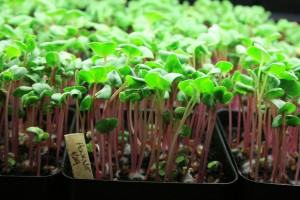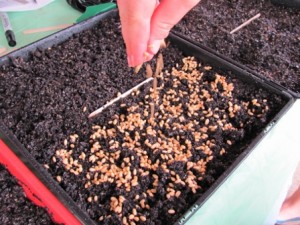Growing Microgreens Indoors at Home
Welcome to February! While we’re one step closer to spring, winter is still a bit rough for many of us gardeners. I don’t feel quite like myself when I’m not getting my hands dirty and harvesting fresh vegetables and flowers to bring home. The winter season does have its value as a time for planning, reflection and goal setting, as I’ve talked about before on the blog. But this winter I decided to make use of what daylight we do have and grow some delicious, nutritious microgreens indoors.
The good news is that anyone with a windowsill can get growing! By doing so you’ll save money at the market, get your hands dirty all through the winter, and experience an early spring right in your home as you watch fresh green growth come to life from the comfort of your kitchen table.
What Are Microgreens?

Microgreens are quite simply, very tender young plants that are harvested way earlier than your typical greens. Any new baby green can be considered a microgreen – kale, choy, lettuce, cabbage, or really anything you can think of that would normally be eaten as a mature leaf. Whereas many of these mature plants would need to grow in the greenhouse and then outside for weeks before they are big enough to harvest, microgreens are ready in about a week – making them quick and easy, and the perfect crop to experiment with if you’re new to growing.
Health Benefits of Growing Microgreens
These little baby greens are packed with nutrition. While all different, microgreens are reported to have higher levels of vitamin C, vitamin E, vitamin K, carotenoids, beta-carotene, protein, phenolic compounds, and antioxidants than their mature counterparts. In fact, NPR reported that new studies show many microgreens possess anywhere from four to six times more nutrients than if they were grown to maturity. You can incorporate microgreens into salads, smoothies, or just eat them solo with a little lemon juice as a great snack.
Guide to Growing Microgreens indoors at Home
- Gather the following materials:
- Two trays with holes on the bottom (and something to catch water if you’re worried about your windowsill). 10’x20′ black plastic greenhouse carrying trays work perfect and should be available at your local garden supply store.
- Seeds of your choosing – about 10 ounces will do. Either Dunn peas or field peas are a great, non-fussy choice.
- Space on a table or windowsill in a room that receives some sun.
- Soil mix – available from your local garden supply store. Look for something that is geared towards seed starting.
- A watering can with a gentle nozzle.
- Scissors or a sharp knife for harvesting.
- Soak your peas in a big jar of water overnight, and then drain the water out and give your seeds a good rinse.
- Fill the bottom of one tray about ½ full with soil (about 2 – 3 inches). Really, that’s all you need!
- Sprinkle your seeds on the soil surface – they can be fairly dense.

- Sprinkle a thin layer of soil on top of the seeds, just enough so that you can’t see the seeds underneath.
- Water your seeds in with a gentle hand. The goal is to wet the soil surface above and just under the seeds – not to saturate the depth of the tray or pot.
- Take your second tray and ‘nest’ it inside the tray now holding the peas, as if you were stacking the trays. This acts to create some pressure on the top of the peas so that they will send down roots below.
- Return to check on the peas daily. When you see that the pea sprouts have begun to push the top tray up, remove the top tray.
- Give the peas a thorough and gentle watering. There won’t be much green growth yet at the point because they have yet to see the light.
- Now take the second tray, flip it upside down, and rest it on top of the bottom tray to act as a cover or umbrella. This encourages the pea shoots to ‘stretch for the light’ and become tall and leggy.
- Remove the lid when the peas have grown tall enough to reach it. Give the pea shoots a good watering, and continue to do so every day as you leave them uncovered.
- When the greens are about 1.5 inches tall (or whenever they look so tasty you just can’t handle it anymore, whichever comes first), harvest! Cut them just below the base of the bottom leaves to ensure tenderness. You can easily sort through with your hands to remove any seed shells that have fallen off the young plants.
- Toss leftover soil mix into your compost pile or garden.

Voila, a taste of spring in the dead of winter! A huge special thank you to Andrea Park, owner and operator of Sonoma Sprouts in Santa Rosa, where she grows and sells sunflower and pea microgreens to local markets such as Oliver’s, Andy’s, Fircrest, G&G and Community Market, as well as to distributors that take her products farther from home. Andrea was kind enough to chat with me and help us prepare for this post on growing microgreens indoors at home.
Next time on the blog I’ll be talking about mistakes in the garden – we’ve all made ‘em, and now is the time to come clean and do things better. Until then, enjoy your greens, and let me know how it works out!







 Family
Family

